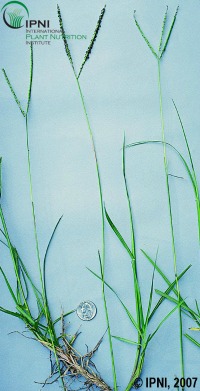Bahiagrass
Adaptation
- South and Central GA.
- Best adapted on sandy soils.
- Tolerant of drought, poor drainage, acid soils, low fertility, and close grazing.
- Very aggressive and forms a dense sod.
Establishment
Plant scarified seed at 10 to 15* lb/A in March or April.
*Seeding rates vary with variety and planting method. When using Pensacola or a Pensacola-type variety, the seeding rate should be 12 to 15 pounds of seed per acre when the seed are drilled into a prepared seedbed. When broadcasting seed onto a prepared seedbed or using no-till methods, increase the seeding rate of Pensacola-type varieties to 18 to 20 pounds per acre. Tifton-9 and TifQuik have much better seedling vigor than other Pensacola-type varieties and lower seeding rates can be used for these varieties. As a result, the seeding rate for TIfton-9 and TifQuik is 8 to 10 pounds per acre on prepared seedbeds and 12 to 15 pounds per acre when broadcasting or planting with a no-till drill.
Varieties
Tifton 9, TifQuik, or UF-Riata. All of these are higher yielding than Pensacola and better suited for pasture and hay production.
In-Depth
 Bahiagrass is a deep-rooted perennial adapted to a wide range of soils in the Coastal Plain region. It spreads by short, stout stolons and is a prolific seed producing plant. Bahiagrass will grow on soils too poorly-drained for bermudagrass, is more shade tolerant than bermudagrass, and can be used in woodland pastures (silvopasture). Though it responds to proper fertility, it does not respond to high fertility as well as improved bermudagrasses and will persist in pastures with a low level of management.
Bahiagrass is a deep-rooted perennial adapted to a wide range of soils in the Coastal Plain region. It spreads by short, stout stolons and is a prolific seed producing plant. Bahiagrass will grow on soils too poorly-drained for bermudagrass, is more shade tolerant than bermudagrass, and can be used in woodland pastures (silvopasture). Though it responds to proper fertility, it does not respond to high fertility as well as improved bermudagrasses and will persist in pastures with a low level of management.
Bahiagrass forage is slightly lower in quality than Coastal bermudagrass. Close grazing is necessary to obtain good utilization. Bahiagrass can become a pest in hybrid bermudagrass hay fields. Keep this in mind when rotating cattle, because seed will germinate after passing through cattle. Bahiagrass introduced to a field (through seed in the droppings of cattle) can crowd out already-established bermudagrass.
Establishment of Bahiagrass
Bahiagrass is best established on a well-prepared seedbed in early spring on upland soils or in late spring on low, moist soils. Bahiagrass can be successfully seeded in early fall in extreme south Georgia. Broadcast or drill 12 – 15 lbs of seed per acre and cover seed ¼ - ½ inch deep. A cultipacker-seeder works well. Apply 40 – 50 lbs of N per acre after the seedlings start to grow. Allow the seedling plants to become well-established before grazing. If crabgrass becomes a problem, grazing or mowing may be necessary to prevent the crabgrass from shading the bahiagrass seedlings.
Dr. Dennis Hancock
Forage Extension Specialist
Crop & Soil Sciences Dept.
